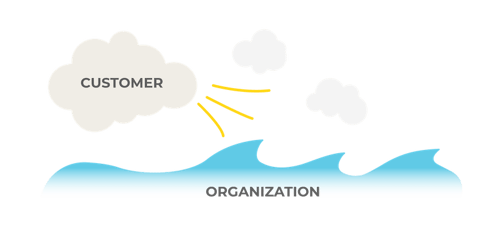Recently, I was thinking about the different ways in which we use linguistic terminology — and about how our different interpretations of language make for interesting conversations. This led me down a rabbit hole as I explored the following terms: customer-centricity, customer-focused, customer-oriented, and customer-driven. While many interpret these terms as identical, they do differ somewhat.
In my mother tongue, Finnish, these definitions could warrant a whole separate blog post about how meaning gets lost in translation. But for the sake of this post, we’ll use English as the business lingua franca.
The idea (supported by my extensive non-academic research) is that whatever term we use does not necessarily explain or justify the action. The action holds much greater importance than the words we use to describe them. This statement might contradict the purpose of this blog, but hopefully, it can create a healthy discussion. As I said, the best discussions start with opposing points of view.
Shedding light on different customer-cultures
Customer-centric companies build a customer-focused culture, where all aspects of a business work together in a customer-driven way to provide necessary customer orientation.
Customer-centricity views the customer’s presence as the reason for all action. On the other hand, in a customer-driven culture, the customer’s needs drive the action. Put simply, both terms regard the customer, and thereby their experience, as a key factor in the business.
This highlights that the customer plays a leading role when taking action. However, the difference lies in the attitude and purpose of the action. Is the existence of the customer the reason for all activity? Is the business founded on the customer’s needs? Or do business’ actions simply seek to achieve superior customer experiences?
The figure below displays the Wiki definitions of each term.
|
Customer Centric |
Customer Driven |
Customer Focused |
Customer Oriented |
|
Consists of a mentality wherein the organization and strategy are built around the customer in the core of all operations. Customer-centric organizations presume that customers are the reason for their existence. |
Customer-driven organizations put customer needs at the center of the business strategy and thereby resulting the strategic objectives. |
Customer-focused businesses emphasize that all the actions aim to deliver superior customer experience. |
The customer needs and wishes are valued over the needs of the business transactions. Makes most sense when business has only a few remarkable customers. |
The Oxford Dictionary to the rescue:
Since the differences between the definitions seem marginal at best, we can turn to the world’s leading dictionary for further insight.
Customer-centric, customer-centered
Centric (a.) = having a center. Centre (n.) = middle point of a line, circle, or sphere, an axis of a rotation, a nucleus, center-piece = a principal item
The customer sits at the heart of a customer-centric culture. The action surrounds the customer, and business decisions are made to impact the customer directly. If the activity does not create any value for the customer, then it has no purpose and should not be taken.

Customer-driven
Driven (a.)/ drive (v., n.) = urge in some direction, compel forcibly, forced into a specific state, operate and direct the course of a vehicle, convey or be conveyed in a vehicle, a capacity for achievement, motivation, and energy
If you’re working in a customer-driven culture, you should know who’s sitting in the driver’s seat.
In this model, the customer is the fuel that drives the business vehicle forward, while the business operates the steering wheel. Just as a driver must know how to drive, a business with customer-driven culture must know its customers.

Customer-focused
Focused (a.) = bring into focus, adjust the focus (of a lens), concentrate on Focus (n.) = the point at which rays or waves meet after reflection or refraction, focal point the center of interest or activity, one of the points from which the distances to any point of a given curve are connected by a linear relation.
In a customer-focused culture, the customer is in the business’ eye. All actions should be taken with the customer in mind and create an adequate customer experience at the very least. While this doesn’t explain how such a customer experience is created or maintained, it is presumably done by catering to the customer’s needs. As such, customer-focused cultures are very similar to customer-centric cultures.

Customer-oriented
Oriented (a.)/ orient (v.) = bring (something) into a clearly understood position or relationship, to stand in relation to surroundings, orientation (n.) = a relative position, a person’s attitude towards or adjustment in relation to circumstances (esp politically or psychologically), the faculty by which birds, etc. find their way home from a distance
The customer forms only a part of the business entity. Here, we have more room for change, adjustments, and tailoring. It’s said that a customer-oriented culture works best for those with a few big clients and those ready to tailor products or business models accordingly. Still, businesses with a customer-oriented culture are there to serve the customer, should the circumstances allow it.

So, how do you define your customer-something-culture?
If you’re looking to define your customer-something-culture, ask yourself this: Do we even need a culture definition? In academia, strict definitions are important, but in business, far less so. At the end of the day, what matters isn’t which one of these definitions we use; it’s that the business and activities include the customer substantially.
Since the differences between the cultures are so nuanced, we must know whether the customer or the action leads. Knowing the customer’s position (whether actions are driven from or towards them) is more important than how you describe them. Nevertheless, with so many terms, consistency remains key to avoiding misinterpretations.
In many businesses, teams, or departments, you can see your customer’s position in relation to your business through a (short) workshop. This would also tackle any outstanding questions about what kind of customer strategy the organization should provide going forward.
Published: Sep 7, 2022


